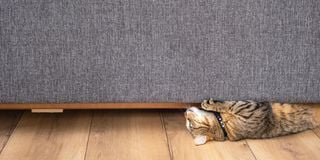Is your home pet-proofed?

Claws are another challenge pet owners face when it comes to furniture.
Pet-proofing your home goes beyond just safeguarding your furniture or household items; it’s also about keeping your beloved pet safe from harmful objects. Njeri Muita, an interior designer, shares tips on how to pet-proof your space while maintaining a stylish home.
Many pets, especially dogs and cats, are notorious for their curiosity. They can open cupboards and doors within their reach. To prevent them from accessing dangerous or delicate items, Njeri suggests using strap locks. These childproof devices, commonly used for toddlers, work just as well for pets, stopping them from opening cabinets and even protecting your doors from damage.
Claws are another challenge pet owners face when it comes to furniture. Njeri recommends using protective covers and investing in pet-friendly fabrics such as Crypton. “Crypton is not only durable but also water- and stain-resistant,” she explains. “It’s also stylish, so you won’t have to sacrifice your home’s aesthetic.” Unlike the plastic covers that were once common, fabric protectors can be easily removed, washed, and put back, offering both practicality and style.
When it comes to flooring, Njeri advises pet owners to consider hardwood floors. “Hardwood is a fantastic option for pet-proofing,” she says, “but it can be noisy when your pet is moving around.” If hardwood isn’t an option, low-pile carpets are a great alternative. These carpets, which have shorter fibers, are modern and also easy to clean, making them ideal for homes with pets.
Another handy tip is to create a designated pet area in your home. “It could be a corner in the kitchen, the living room, or any other suitable spot,” Njeri suggests. Having a specific area for your pet helps contain any mess and offers your furry friend a personal space to retreat to. A cozy blanket in that spot will keep them comfortable without damaging your furniture.
Cats, in particular, are known for scratching and climbing, which can pose challenges for pet-proofing. “If you love long curtains, you may need to switch to shorter ones to prevent climbing,” says Njeri. Alternatively, barrier gates can keep pets away from areas with delicate fabrics. Dining table legs are another common victim of cat scratching, but a simple fix is to wrap sisal rope around the legs, giving your cat a fun and safe alternative to scratch and play around with.
While pet-proofing your home is essential, Njeri emphasizes that training your pet is just as important. “As a pet owner, you have the responsibility to teach your pets where they can and cannot go,” she says. A well-trained pet paired with thoughtful home adjustments will make life smoother for both you and your furry companions.





